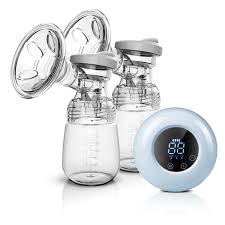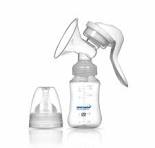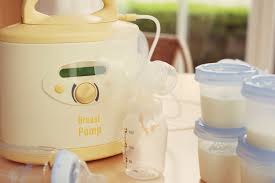Breast Pumps
Specifications:
Type: Electric, manual, or battery-operated
Suction Strength: Adjustable levels for personalized comfort
Bottle Capacity: Varying bottle sizes available
Materials: BPA-free, food-grade silicone, and plastic components
Weight and Portability: Lightweight and compact designs for on-the-go usage
Cleaning and Maintenance: Easy to disassemble and clean components
Features:
Efficient Pumping: Breast pumps are designed to mimic the natural sucking motion of a baby, ensuring effective milk extraction.
Adjustable Suction Levels: Moms can personalize the pumping experience by adjusting the suction strength to match their comfort level and milk flow.
Double Pumping: Some breast pumps allow simultaneous pumping of both breasts, saving time and enhancing milk production.
Night Mode: Breast pumps with quiet operation and night mode features provide convenience during late-night or early-morning pumping sessions without disturbing others.
Built-in Rechargeable Battery: Electric breast pumps with rechargeable batteries enable usage without relying solely on a power outlet, making them portable and versatile.
LCD Display: Clear and easy-to-read LCD screens provide information on pumping settings, suction levels, and pumping time.
Memory Function: Breast pumps with memory features can save preferred pumping patterns, making future sessions more efficient and comfortable.
Customization Options:
Breast Shield Sizes: Different breast shield sizes ensure a comfortable fit for moms of all shapes and sizes.
Pumping Modes: Customizable pumping modes such as massage mode and expression mode allow moms to find the pumping style that suits them best.
Timer Function: Customizable timer settings help moms track pumping duration and schedules.
Benefits and Features of Breast Pumps:
Convenience: Breast pumps provide nursing mothers the flexibility to collect and store breast milk, allowing others to feed the baby when the mother is not available or during working hours.
Relief from Engorgement: Regular use of breast pumps can help alleviate discomfort caused by engorged breasts, preventing complications like mastitis.
Establishing Milk Supply: Breast pumps can stimulate milk production and maintain a healthy milk supply, especially when breastfeeding directly is not possible.
Maintaining Breast Milk Production: Even when apart from the baby, moms can continue pumping breast milk, ensuring a consistent supply and avoiding any interruptions in breastfeeding.
Supporting Mothers with Low Milk Supply: Breast pumps aid mothers with low milk supply by enhancing milk production through regular and efficient pumping.
Bonding and Shared Feeding: Partner involvement in feeding using pumped breast milk helps strengthen bonding and allows others to share the joy of feeding the baby.
Breast Pumps

Manual Breast Pumps:
Operated by hand, these pumps require the user to manually create suction by squeezing a handle or using a lever.
Typically compact, lightweight, and portable.
Ideal for occasional use or when a power source is unavailable.

Double Electric Breast Pumps:
Similar to single electric pumps but equipped with two pumping units, allowing the user to express milk from both breasts simultaneously.
Efficient for mothers who need to pump frequently or have limited time.

Single Electric Breast Pumps:
Powered by electricity, these pumps have a single pumping unit that operates with an electric motor.
Suitable for mothers who plan to express milk regularly but may not need to pump both breasts simultaneously.

Hospital-Grade Breast Pumps:
Designed for heavy, frequent use and often recommended for mothers with specific medical needs.
Offers powerful suction and efficient pumping.
Typically available for rental from hospitals or specialized suppliers.
